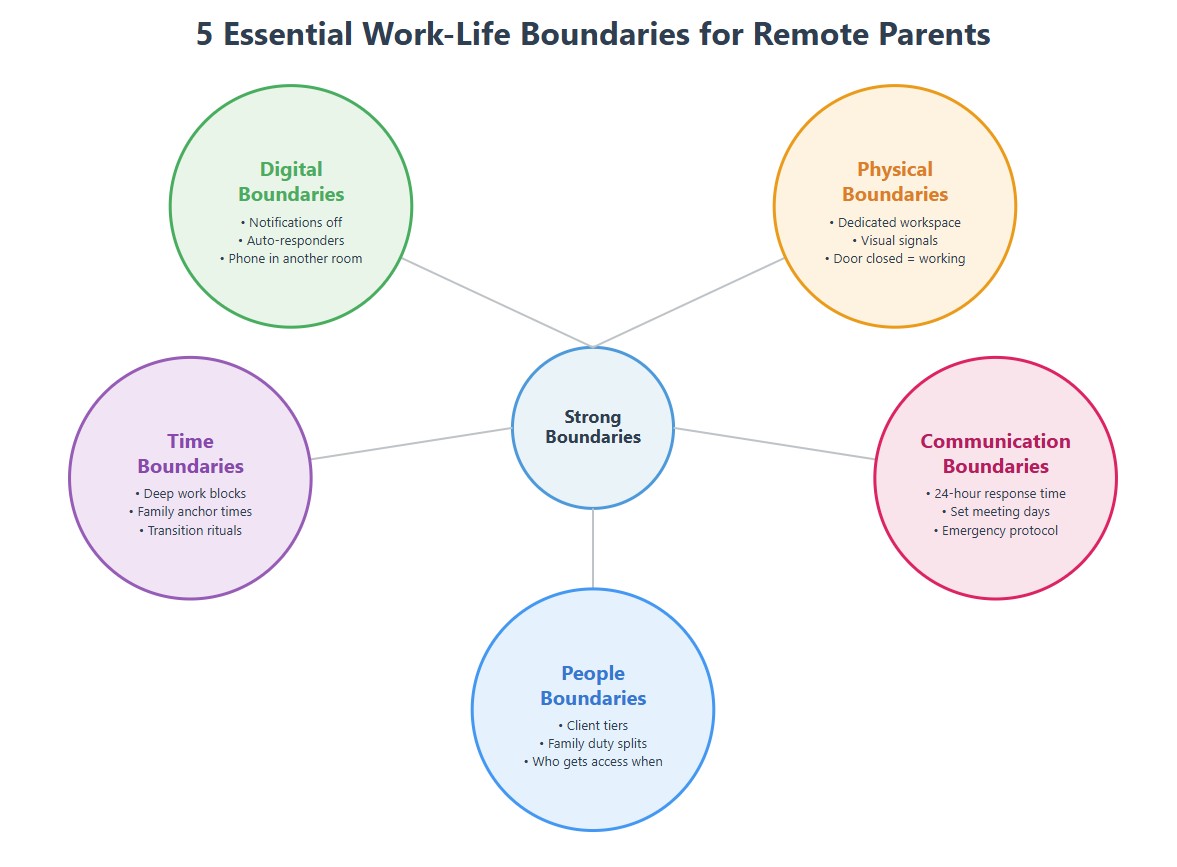The WhatsApp message popped up at 7:45 PM while I was giving Shaw a bath.
“Quick question about tomorrow’s deliverables?”
My stomach knotted. Quick questions from this particular client were never quick. I’d already worked a full day. Bath time was sacred family time—one of the boundaries I’d fought to protect. But if I didn’t respond now, I’d spend the entire evening anxious about it, mentally composing replies while pretending to be present for bedtime stories.
So I responded. “Sure, give me 10 mins.”
Shaw’s face fell. “You said no work after dinner, Dad.”
He was right. I’d set that boundary. Then immediately broken it. Again.
That night, after Shaw finally fell asleep, I realized something: I didn’t have a boundary problem. I had a clarity problem. I’d told everyone I had boundaries, but I’d never actually defined what they were, communicated them properly, or created systems to enforce them.
This is part of our complete guide on work-life balance for remote working parents, where we address the practical systems that make work-from-home life sustainable. If you’ve ever set a boundary only to watch it crumble the first time it was tested, this post will show you the five essential boundary types every remote working parent needs—and how to actually make them stick.
The Problem: Why Boundaries Keep Failing
Here’s what nobody tells you about work life boundaries remote working parents try to set: most fail not because you lack willpower, but because they’re vague, uncommunicated, or impossible to enforce.
I spent three years setting boundaries that collapsed immediately:
“I don’t work weekends” lasted until a client emergency Saturday morning.
“No calls after 6 PM” disappeared when a timezone-confused prospect wanted to chat at 7.
“Family dinners are non-negotiable” became negotiable the moment I started checking WhatsApp at the table.
The problem wasn’t that these were bad boundaries. The problem was threefold:
1. They weren’t specific enough. “I don’t work weekends” sounds clear until you realize you haven’t defined what counts as work. Checking emails? Responding to urgent requests? Planning next week? Without specificity, every decision becomes a judgment call—and judgment calls favor whoever’s demanding your attention right now.
2. They weren’t communicated to the right people. I’d tell myself I had boundaries, but my clients didn’t know them. My family didn’t understand them. Even I didn’t consistently remember them. Boundaries that live only in your head aren’t boundaries—they’re wishes.
3. They had no enforcement mechanism. When a boundary was tested—and they’re always tested—I had no system to fall back on. Just willpower and guilt. Willpower fails. Guilt accumulates. Neither creates sustainable boundaries.
After Shaw called me out that bath time evening, I realized I needed to completely rebuild my approach to remote work boundaries with family and clients. Not more rules. Better systems.

The Five Essential Boundary Types
After six years building my agency from home, I’ve learned that work family boundaries fall into five categories. You need all five—and most parents only set one or two.
Boundary Type 1: Digital Boundaries
These control when and how technology connects you to work.
What this looks like:
- Notifications turned off after 6 PM and before 8 AM
- Work email removed from personal phone (or separate phone entirely)
- WhatsApp/FB Messenger set to “Do Not Disturb” during family time
- Auto-responders that clearly state availability hours
- Separate browser profiles for work and personal use
My digital boundaries:
- Work laptop closes at 5 PM. If I need to work evenings, I schedule it and communicate it—not reactionary checking.
- My phone goes in another room during 6-7:30 PM family time—not just face-down on the table, but completely out of reach.
- Email auto-responder: “I respond to emails between 8 AM-5 PM, Monday-Friday. For genuine emergencies, call [my phone number].”
The last one was transformative. Clients learned that “urgent” email at 8 PM wouldn’t get a response—but actual emergencies had a path. Ninety percent of “urgent” requests turned out not to be urgent at all.
Boundary Type 2: Physical Boundaries
These create spatial separation between work and family life in the same home.
What this looks like:
- Designated workspace that’s exclusively for work
- Visual signals (closed door, red cup on desk, “in meeting” sign) that communicate availability
- Physical separation of work materials from family spaces
- No working from bed or main family areas
- Clear line between “office” and “home” even in same building
I have a separate office room, which makes physical boundaries easier. When my office door is closed, I’m in deep work mode and can’t be interrupted unless it’s an emergency. When the door is open, I’m available. Shaw learned this system in about three days.
Physical boundaries matter because your environment shapes your mental state. When work materials are everywhere, you’re mentally at work everywhere. Having a dedicated office space—even if it’s small—helps your brain switch modes. If you don’t have a separate room, create visual separation with a folding screen, room divider, or designated corner.
Boundary Type 3: Time Boundaries
These protect specific blocks of time for focused work or guaranteed family presence.
What this looks like:
- Non-negotiable work blocks when you’re unavailable for family interruptions
- Non-negotiable family blocks when you’re unavailable for work requests
- Buffer time between work and family (transition ritual)
- Realistic work hour ranges communicated to clients
- Scheduled flexibility (not constant availability)
My time boundaries:
- Deep work: 8-11:30 AM, Monday-Friday. This is sacred. Clients know I don’t schedule calls during this window.
- Family anchors: 6-7:30 PM every weekday. Dinner, connection time, bedtime routine. Work genuinely doesn’t interrupt this unless there’s a real emergency.
- 15-minute transition walks at 5:45 PM. Physical movement that signals to my brain: work mode is ending, family mode is beginning.
The key to time boundaries working is specificity and consistency. “I usually finish work around 5 or 6” isn’t a boundary. “I’m available for calls Tuesday and Thursday 1-4 PM” is a boundary.
Boundary Type 4: Communication Boundaries
These control how, when, and through what channels people can reach you.
What this looks like:
- Defined response time expectations (“I respond within 24 hours”)
- Preferred communication channels for different urgency levels
- Boundaries around synchronous communication (calls/meetings)
- Clear working hours stated in email signature
- “Office hours” concept even when working from home
My communication boundaries:
- Async-first approach: Email and project management tools for most communication. Calls only when necessary.
- 24-hour response time for emails: Clients know they’ll hear from me within one business day, not immediately.
- Two designated meeting days: Tuesday and Thursday afternoons only. No scattered calls throughout the week.
- Emergency contact method: For genuine emergencies, clients can text my mobile. This has been used twice in six years.
The magic of communication boundaries is that they set expectations before requests arrive. When clients know my response timeline, they plan accordingly instead of expecting instant replies.
Boundary Type 5: People Boundaries
These define who gets access to you when and under what circumstances.
What this looks like:
- Clear family roles during work hours (who handles kid interruptions)
- Client tier system (who gets priority access and faster responses)
- Saying no to projects/clients that don’t respect boundaries
- Teaching children age-appropriate understanding of work time
- Partner agreements about division of childcare during work hours
This is where I struggled most. I treated all client requests as equally urgent and all family needs as infinitely flexible. The result? Constant conflict and nobody happy.
My people boundaries:
- Partner split: Hayley handles morning kid needs Monday/Wednesday/Friday. I handle Tuesday/Thursday. We both know our “on duty” days and plan accordingly.
- Client tiers: Premium clients get priority, but even they know my availability windows. Budget clients get scheduled response times.
- “Boundary-respecting clients only” policy: I’ve fired clients who repeatedly ignored my stated availability. It’s not worth the stress.
This connects directly to setting work from home boundaries that protect your focus time while maintaining flexibility when needed.

How to Actually Enforce Your Boundaries
Setting boundaries is step one. Enforcement is where most parents fail. Here’s the system that works:
Step 1: Document Your Boundaries Clearly
Write them down. Not just in your head—actually document them. I have a one-page “Working With Me” document that outlines:
- My working hours and availability
- Expected response times
- Best ways to reach me
- When I’m unavailable (and what qualifies as emergency)
- How I handle urgent requests
I share this with new clients upfront. Crystal-clear expectations prevent most boundary violations before they happen.
Step 2: Communicate Proactively, Not Reactively
Don’t wait until someone crosses a boundary to tell them it exists.
For clients: Include boundary information in contracts, onboarding documents, and email signatures.
For family: Have actual conversations. I sat Shaw down and explained: “When my office door is closed, I’m working and can’t be interrupted unless you’re hurt. When the door is open, I’m available.” We talked through what counts as an emergency versus what can wait, and he got it pretty quickly.
For yourself: Set calendar reminders for your boundary transitions. My phone buzzes at 5:45 PM with “Transition walk – end work mode.”
Step 3: Enforce Consistently (Especially Early)
The first time a boundary is tested is the most important. If you cave immediately, you’re teaching everyone the boundary is negotiable.
When a client emails Sunday evening expecting Monday morning response, I wait until Monday business hours to reply—even if I see it Sunday. I’m training them that weekend emails don’t get immediate responses.
When Shaw interrupts during deep work time for non-emergencies, I gently redirect: “I see you need me, and I want to help. My work block ends in 20 minutes. Can it wait, or is someone hurt?” Ninety-five percent of the time, it can wait.
Consistency in the first month establishes the pattern. After that, boundaries become the default expectation.
Step 4: Build Flexibility Into Your Boundaries
Rigid boundaries break. Flexible boundaries bend without breaking.
I don’t say “I never work weekends.” I say “I typically don’t work weekends, but I’ll schedule weekend work in advance when necessary and take equivalent time off during the week.”
I don’t say “family time is 6-7:30 PM with zero exceptions.” I say “this is protected family time, and work interruptions require genuine emergencies and will be discussed with family first.”
The goal isn’t perfection. It’s creating a sustainable framework that works more often than it fails.
Step 5: Review and Adjust Quarterly
Your kids grow. Your business evolves. Your boundaries should adapt.
Every three months, I review: What boundaries are working? Which ones am I consistently breaking? What needs to change?
Last year, I realized my “no evening work” boundary was causing stress because some tasks fit better in evening hours. I adjusted: “No reactive evening work (emails, calls). Proactive evening work (writing, planning) is fine if scheduled in advance and communicated to family.”
Boundaries that reduce stress are good. Boundaries that create guilt aren’t working—adjust them.
Implementation: Your 7-Day Boundary Setup
Don’t try to implement all five boundary types this week. Start here:
Day 1-2: Audit Your Current Boundaries
What boundaries do you think you have? Write them down.
Where are they failing? When do they get broken?
Who doesn’t know about them? (Probably more people than you realize.)
Day 3-4: Choose One Boundary Type to Focus On
Which of the five types would give you the biggest immediate relief?
If you’re drowning in constant notifications: Start with digital boundaries.
If family interruptions are killing your focus: Start with physical boundaries.
If you’re working 24/7: Start with time boundaries.
Day 5: Document and Communicate
Write down your specific boundary for this one type.
Tell everyone who needs to know: clients, family, yourself.
Set up any necessary systems (auto-responders, visual signals, calendar blocks).
Day 6-7: Practice and Enforce
Test your boundary. Expect it to be tested.
Enforce it gently but consistently.
Notice what works and what needs adjustment.
Common mistakes to avoid:
- Trying to implement all boundaries at once (overwhelming)
- Not communicating boundaries before enforcing them (unfair to others)
- Breaking your own boundaries “just this once” (teaches everyone they’re not real)
- Setting boundaries that don’t match your actual life (they’ll fail immediately)
The goal this week isn’t perfect boundaries. It’s starting the practice of protecting your time and energy intentionally.
Conclusion
Work life boundaries remote working parents need aren’t about being rigid or unavailable. They’re about being intentional. About making choices instead of constantly reacting. About protecting what matters—both work focus and family presence.
You need all five types:
- Digital boundaries that control when technology connects you to work
- Physical boundaries that create mental separation in shared spaces
- Time boundaries that protect focus and family blocks
- Communication boundaries that set clear expectations
- People boundaries that define who gets access when
The boundaries themselves matter less than the enforcement system. Document them. Communicate them. Defend them consistently. Adjust them when needed.
Shaw doesn’t interrupt my deep work anymore—not because he’s afraid to, but because he knows when I’ll be available and trusts I’ll show up then. My clients don’t expect instant evening responses—because I trained them not to.
This connects to understanding why work from home parent guilt happens and how to release it—often, guilt comes from unclear boundaries that leave you feeling like you’re failing everyone.
Your boundaries will look different than mine. You might need evening work blocks. You might need morning family time. The framework stays the same: clarity, communication, consistency.
What’s one boundary you’re going to implement this week? Drop a comment—sometimes hearing how others approach boundaries sparks ideas for your own situation.
Continue Reading
For more strategies on creating sustainable work-from-home systems, explore these articles:
Work-Life Balance for Remote Working Parents: The Complete 2025 Guide – Our comprehensive pillar covering all aspects of achieving harmony while working from home
Work From Home Boundaries: Setting Limits Without Guilt – Practical systems like visual signals and communication scripts that make boundaries enforceable
Work From Home Parent Guilt: Why It Happens and How to Release It – Address the guilt that undermines even the best boundaries
Part of the Work-Life Balance & Harmony series. For the complete guide, see our Work-Life Balance for Remote Working Parents pillar post.
Split screen- a stressed female parent with laptop at dinner table, phone notifications, husband and children looking frustrated










